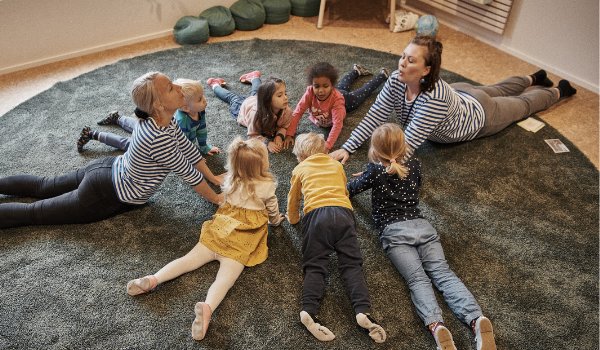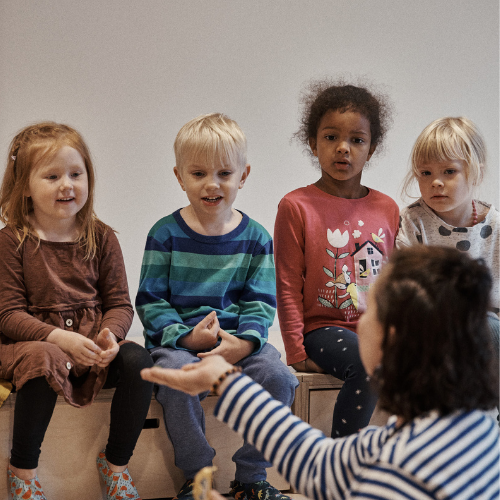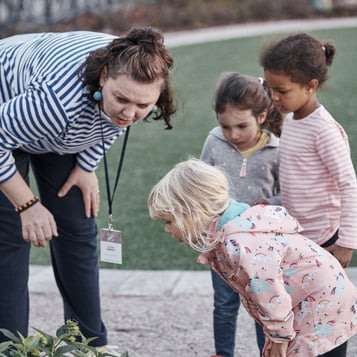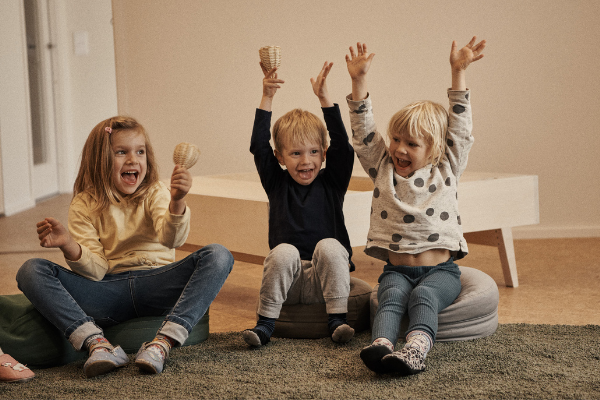The Top 10 Benefits of the Holistic Approach to Early Childhood Education

Holistic development is the social, emotional, physical, mental, and intellectual growth of a person. It’s an important focus area in early childhood education and care because children develop rapidly between the ages of 0 and 6 years old. Just consider an infant versus a 6-year-old. How much more can the 6-year-old accomplish than the infant in each of those areas? The answer is quite a lot! Therefore, we have a critical opportunity in early childhood education and care to foster children’s holistic development. Such a focus has many benefits for children, and we’re going to discuss the top 10 benefits of the holistic approach in ECE, which are the following:
- A child is seen as a whole person.
- A holistic education is child-oriented.
- Educators support and focus on children's overall wellbeing.
- It builds children's confidence.
- It encourages children's active participation.
- Children understand big concepts instead of small details.
- Children learn to use their reasoning skills.
- It is motivating for children because it combines playfulness and learning.
- It broadens children's worldview.
- It helps children interact with others and understand differences.
1. With holistic development in mind, a child is seen as a whole person
When a child’s education focuses only on the development of their academic skills, it ignores so many other areas of their growth. If children sit at their desks all day doing exercises, for example, they can’t work on their physical skills, like running, jumping and playing in physically demanding ways. This in turn affects their mental state. Research has shown that children who play grow up happier and healthier. Therefore, children’s mental health could suffer if they can’t move their bodies and play on a regular basis.
When we take a holistic approach, the child is treated as a whole person. This means that no aspect of their development and learning goes unaddressed. Instead, educators consider the social, emotional, physical, cognitive and linguistic growth that the child experiences. They determine how to support and foster the child’s learning in each area. Continuing with the example above, children who receive holistic support in their learning experience get to challenge themselves physically, and this in turn helps them stretch themselves mentally. Because all areas are addressed, they will feel happier, healthier and more prepared to take on cognitive challenges in the classroom.

2. The holistic approach is child-oriented
When we consider holistic development in early childhood education, we see the child as a whole person. They are not ‘humans in the making.’ They are already unique individuals who deserve the same level of respect and attention as any other person. They are, however, young people who have different needs than adults. Because they are still developing in all areas of life, we must consider how to best support them as they grow. We also need to think about how they think and understand what’s around them.
What does this mean in practice? Well, first of all, children do not have the same level of understanding about certain phenomena in life. While something may seem straightforward to us, it could be very new and unusual to children. For example, the concept of sitting down and eating together is something many adults have been socialized to do so it does not even occur to them as odd. However, children are still relatively new to this experience. They have to learn the manners, customs and expectations that we also learned as children. In the holistic approach, teachers see this situation from the children’s perspective and make efforts to help them understand what we do at mealtime and why.
3. The holistic approach supports and focuses on children’s overall wellbeing
In a traditional classroom, the focus is solely on the children’s ability to reach academic milestones. If a child cannot achieve their learning goals, it is viewed as a shortcoming on their part. Educators do not take the next step to discover if something else is affecting the child’s ability to learn, which is typically the case! For example, they might have something stressful going on at home or they do not feel well that day. Such factors affect their motivation and impact their approach to learning.
A holistic approach to education, on the other hand, emphasizes children’s overall wellbeing, not just their academic success. In practice, this means their social, emotional, physical and intellectual health are taken into account. Educators address all aspects of their personhood so they feel supported and cared for every day. If a child does have home trouble or a headache, the teacher follows up with them and makes sure they get the help they need. They appreciate that children must achieve overall wellbeing before accomplishing academic skills, and they work hard to ensure that the former is achieved before pursuing the latter.
4. A focus on holistic development builds the child’s confidence
Letting children practice their skills in all areas of holistic development also helps them to develop their confidence. Let’s look at an example. In a traditional classroom, academic skills are central. If a child does not reach the same academic level as another child, they might feel bad about themself, which leads to a lack of self-confidence and self-esteem. They can’t utilize their strengths in other areas, so they feel ‘behind’ compared to their classmates. In a setting that emphasizes holistic development, that child would be able to practice their skills in other areas where they might be stronger, like in physical education or team-oriented activities. Most importantly, however, they would not be ‘behind’ at all - teachers who are trained to understand the milestones of holistic development also understand that each child is unique and develops at their own pace.

5. A holistic education encourages children’s active participation
From a very young age, children want to be a part of what they see around them. They are curious and enthusiastic, and a holistic education takes advantage of this energy! In a traditional classroom, the teacher is the ultimate authority and children passively learn what the teacher tells them. Learning is linear and only the children learn. On the other hand, a classroom concentrated on holistic development fosters learning for everyone. The children can learn from the teacher and vice versa! Children contribute to the conversation in class and draw on prior knowledge and experiences to enrich their learning.
One way we foster active participation at HEI Schools is by having regular children’s meetings. In these monthly gatherings, teachers ask children to share their thoughts about daily life at the learning center and how they think it can be improved. The children discuss different matters and vote on issues that directly affect them. Because educators care about children’s emotional, social, physical and intellectual wellbeing, alongside their academic development, they encourage children to play an active role in their own educational journey.
Why does this matter? A sense of participation contributes to the development of children’s self-esteem, identity, and wellbeing. Making decisions and actions for oneself produces a powerful sense of achievement and success. When children have opportunities to make choices, to attempt tasks by themselves, and to take on increasing responsibilities, their sense of self as competent members of society grows. The holistic approach to learning and development requires that we consider children as essential stakeholders in the processes of learning.
6. When their holistic development is considered, children come to understand big concepts instead of just small details
With a holistic approach to education, teachers focus on helping children see the big picture. They provide opportunities for children to test out a variety of skills and because the children are not focusing on just one skill, they learn things in context. For example, a typical day at HEI Schools almost always includes time outdoors and teachers sometimes guide children to do simple activities, like gather sticks, leaves and stones. In such a situation, the teacher might ask the children to count how many of each item they find. After that, the children could sort them by size or create sequences on the ground. They could also organize the different objects by color or create patterns with the materials they find.
While this activity promotes mathematical thinking, a typically academic skill, children will remember this lesson more clearly because they get to practice it in a fun and engaging way. They also see the real-life implications of counting and how it can help them in different situations. Because it’s taught in a relaxed, enjoyable atmosphere alongside other skills versus at a desk with focused worksheets, the learning is more meaningful. The children learn why skills like adding and sorting are important because it happens in real life.
7. Children learn to use their reasoning skills in a classroom that emphasizes holistic development
With a holistic approach to education, learning happens in context. Educators use real-life examples to make the learning ‘real’ for children. Project-based learning is a typical method in the holistic approach because it lets children practice skills in multiple learning areas at once. Children also learn how to reason and solve problems because they have to make decisions about different aspects of these projects.
For example, one HEI Schools project is a puppet theater. To begin, the teacher introduces the idea to the children and asks them to think about the storyline. They work together on the plot, and this requires social skills like listening, taking turns to speak, and negotiating. Once the story is decided, the next step is to make the puppets. Children practice their fine motor skills, creativity and problem-solving abilities because the characters must match the storyline they created. They also need to share and work together with the supplies they have. Finally, it’s show time! Memorizing the story, practicing the performance and building confidence are all steps in this process, and children become adept at many skills all at once!

8. A holistic education is motivating for children because it combines playfulness and learning
From a holistic perspective, learning takes place everywhere and all the time, whether it’s dressing up, eating or going for a walk. Because of that, teachers encourage children to ask questions about what they find interesting, and together, they look for the answers in a hands-on, interactive way. As opposed to the traditional approach, where children are forced to sit at their desks to learn subjects like science, the holistic approach allows them to engage in experiments, explore the outdoors and be active agents in their learning process. Because they can follow their interests, children are more motivated to learn.
9. An education with holistic development in mind broadens children’s worldview
Good communication and interaction skills help children build local and intercultural relationships as well as their own identities, which promotes their wellbeing and performance over time and broadens their worldview. In order to be able to interact, it is important for children to understand their own backgrounds and to be able to understand and respect others’ backgrounds too.
With holistic development in mind, teachers intentionally help children develop their sense of cultural identity with a focus on their own cultural backgrounds and heritage. Children experience their own or different cultural customs through play, games, and celebrations which helps them adapt to or change the culture they are living in for the better.
Besides that, children receiving a holistic education get to know other people, languages, and cultures. Teachers model a culturally open-minded approach and guide children to be friendly and display good manners. They foster cooperation by allowing children to work together in all types of activities. Ceating such an inclusive atmosphere helps each child feels accepted too, which positively impacts their self-esteem and self-image.
10. The holistic approach helps children interact with others and understand differences
Nowadays, children grow and develop in culturally, linguistically, and socially complex worlds which require strong global citizenship skills. These skills include active listening abilities, the ability to recognize and understand different views, and the capacity to recognize and reflect upon personal opinions. The holistic approach builds a foundation for these skills to flourish.
Interaction skills help children express themselves and understand others better. Considering the globalized context we live in, early childhood education should focus on building children’s awareness about the world, their understanding of the importance of sustainability, and their ability to take an active role and participate in the global community.
Are you interested in implementing the holistic approach in your classroom? The HEI Schools Teacher Diploma program introduces you to the Finnish style of teaching that emphasizes holistic development and makes learning fun for children and teachers. Click the button below to learn more!





